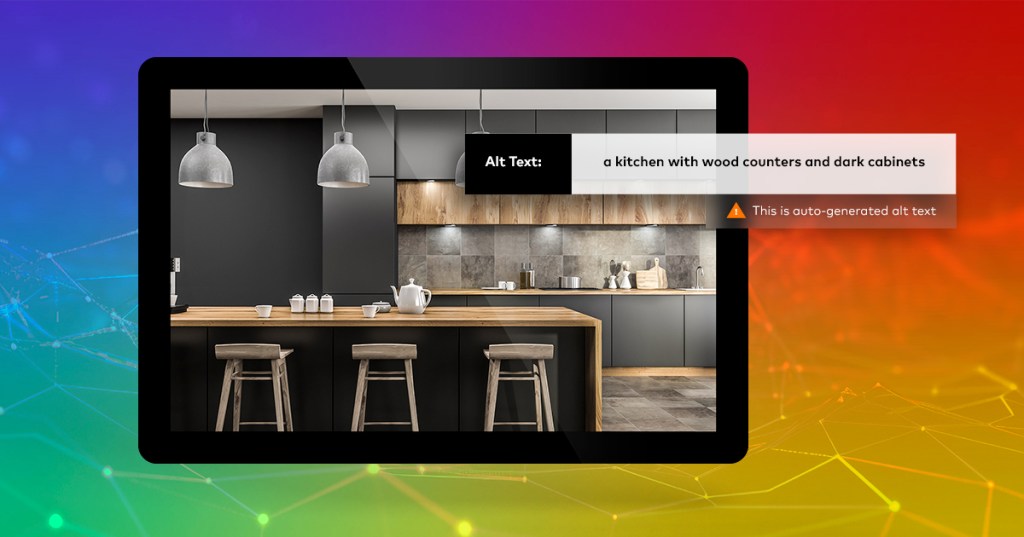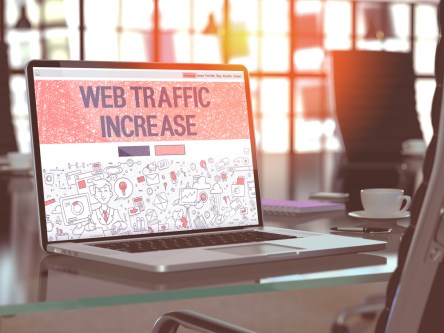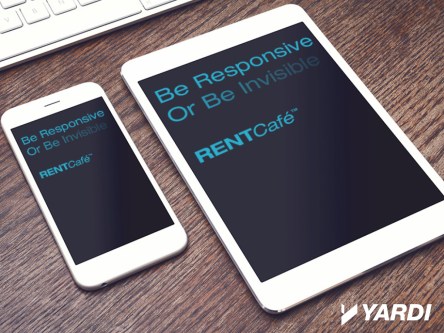Great news for RentCafe websites on the RentCaffeine platform! We’ve added an AI alt text generator that makes uploading new photos faster and easier. This tool creates alternative text — more commonly known as alt text — automatically for you. Alt text is copy that describes images using words, making your website more accessible to people who have a hard time viewing or understanding pictures. That’s right, as promised by countless articles, artificial intelligence is here to help you! (As a bonus, we promise that this version of AI has no aspiration to take over the world.) Keep reading to learn what it is, why it’s important and how to use it. Then check out some client feedback about our new AI tool for RentCafe websites. AI tool for alt text Our AI tool for alt text automatically writes image descriptions for you, so you don’t have to. It will create high-quality image descriptions of new photos you add to your media library. It will also generate descriptions for existing photos that are missing alt text, helping you quickly fill accessibility gaps. Why it’s important Alt text is alternative text that that describes the appearance or function of an image online. It’s important to people and search engines alike. Alt text is read aloud by screen readers used by visually impaired users. If an image fails to load on your site for any reason, the alt text will be displayed so people know what’s supposed to be there. Alt text is also crawled and indexed by search engines to better understand the content of your page. Unfortunately, it’s often overlooked or skipped in the process of uploading photos. Entering alt text can be time consuming when you’re working with more than a handful of images. Manually entering alt text also adds potential for typos and other human errors. Mislabeled images are just as bad as unlabeled images. Our AI alt text generator fixes this, making the process of adding alt text to your images easy and instant. “I’m proud that RentCafe continues to build accessible websites. We want to ensure our websites are inclusive, and the AI alt text generator will help our clients with that,” said Nomo Nagaoka, project manager for RentCafe. “Although alt text is simple to manually set up, it is often missed — either it gets forgotten or people run out of time. But now we’ve solved for this. Any time an image is uploaded, through our AI solution, we’re generating recommended alt text. It’s easy to review and edit as necessary. No images will be without alt text moving forward, and our clients will spend less time trying to manually write out descriptions of the images.” (It’s only fair to share that when Nomo first previewed this technology to our audience at OutREACH Live in Palm Springs, the attendees actually started applauding mid-presentation.) How to use it As stated earlier, you can add auto-generated alt text to images that you upload to your media library, as well as existing images that are missing alt text. The automated alt text generator was enabled for all clients in the March release, so log in and check it out if you haven’t made website updates lately. You can review and accept AI-generated alt text from the media library, Site Editor or your SEO Dashboard. When alt text has been auto-generated, a message appears below the image alt textfield that says, “This is auto-generated alt text.” It’s a best practice to quickly assess the auto-generated text to make sure it works for the image being described. Review your alt text and either confirm or modify it before saving your changes. If you save changes, the modified alt text gets saved and the “This is auto-generated alt text” message will be removed. Does it help with SEO? Kind of. By default, having some alt text is better than having none at all. Search engines like...
Online Marketing
Ebook for Senior Living
Knowing what not to do is as important as understanding what should be done. That’s a key takeaway from a new Yardi ebook designed to help senior living communities market their offerings effectively. “8 Do’s & Don’ts for Senior Living Community Websites” offers tips for sprucing up digital curb appeal, maximizing the impact of a website’s most visited pages and more. The list of “dos” includes showing multiple views of a floor plan, helping prospects identify the unit that meets their needs and boosting traffic by sharing images on social media. The “don’ts” address rising above a bad user experience, avoiding inferior photography, not expecting photos to speak for themselves and resisting the impulse to mimic competitors. Looking for new ways to use your marketing website to make your senior living community both more visible and more appealing to prospective residents? Read the ebook for all the do’s and don’ts of getting those prospects to your page and into your...
Websites that Wow
Standing out in senior living
The first tour a prospect takes is not at your community. It’s on your website. Nearly 90% of senior living prospects will visit a community’s website before they ever reach out. For senior living marketers, that means the community’s online presence needs to be as impressive as its physical campus is. We’re talking clean, modern designs. Engaging content. Interactive floorplans. These elements are essential for educating and converting visitors to prospects. But building out these features is easier said than done. Not many senior living providers have staff with web expertise or the resources on hand to run such a crucial project. That’s where Yardi can help. Our RENTCafé team doesn’t just work on online portals for residents and family members. They also have a team of creative professionals who design and develop senior living websites for providers. That includes community-specific websites as well as brand-level corporate sites, all of which can be managed by the senior living marketer from a single solution. Senior living website themes galore To make things simple, we’ve already built out over 70 website designs for senior living providers to choose from. There’s a wide range of styles to fit any market, and the themes are configurable too. Unlimited pages are included with any RENTCafé website, allowing marketers to promote their values, activities or anything else about their communities. If the senior living community wants something uniquely theirs, our RENTCafé creative team can design a full theme to represent the brand’s vision. The team works together directly with the senior living provider to determine goals, feature requirements, content needs and, of course, the look and feel. Mobile optimized for modern devices Websites used to have an entirely separate site dedicated for viewing on mobile. But as Google has updated...
Increasing Conversions...
Landing Pages Part II
In last week’s post, we answered your basic questions about landing pages: What is a landing page? Why is it powerful? What should it include? But landing pages are tricky tools. What they should exclude is just as important as what they should include. When landing pages include undesirable features, your conversion rate suffers. That means that you sabotage your return on investment, paying more for less. The pointers below will help you craft a landing page that fulfills its potential. What should my landing page exclude? Landing pages aren’t like other pages on your website. More information and options is not better! The features below decrease the likelihood of conversion. Exclude them from your landing pages. Navigation links The menu on your website or any other navigation links should be hidden from view. Remember, prospects reach your landing page through an ad with a specific purpose. Presenting other options will be confusing at best. At worst, the links will navigate them away from your offer. Multiple calls-to-action (CTA) If a prospect clicked your ad for a studio apartment deal, there should be a single CTA for studio apartments. Other CTAs or even social media links are a distraction, resulting in a lower conversion rate. Presenting multiple CTAs on a landing page activates Hick’s law. Increasing the number of options increases the time needed to make a decision. That extra effort and time decreases the likelihood of a successful conversion. If you’d like to offer multiple deals, create multiple landing pages for each one. There is no such thing as too many landing pages! Each page offers a tailored user experience. Long-winded copy When it comes to copy, or text, stick to details about the benefits of your offer. Prospects have short attention spans....
Drive More Traffic
To Property Websites
Remember when property marketing was all about foot traffic? Not anymore. In this digital era, an increasing number of apartment seekers start their search online, long before they ever set foot in your leasing office. And the most recent NMHC Kingsley Renter Preferences Study showed that 80% of renters visited the community or company wesite during their apartment search. As a savvy property manager, you already know that online is the name of the game. And you’ve got a website for your property. But how do you get people to visit it? Not everyone has the budget or staff for paid search ads. Fortunately, that’s not the only answer. Here are three inexpensive things you can do to drive more traffic to your property websites. Go Mobile First things first, you can’t get traffic if it can’t find you. Not only is a mobile-friendly website important for easy viewing from a phone, it’s also critical to help your site get found during mobile searches. In fact, did you hear about “Mobilegeddon” in April 2015? This was when Google updated its algorithm so that only responsive websites appeared in mobile search results. A lot of US businesses lost search traffic because they weren’t mobile friendly. Don’t let that happen to you! First, update your website to a responsive design that works on any size screen to make sure it appears in all search results. Then be sure to include important details that mobile searchers may be looking for near the top of the page. Give them easy access to your phone number, office hours and vacancies. Brand Everything Your property website is one of your most powerful marketing tools. Are you using it to your full advantage? It’s time to put your website address on...
Winning Websites
Creating Digital Curb Appeal
Curb appeal. It’s a real estate term that almost everyone is familiar with. It refers to how attractive your property looks to potential renters or tenants. Is the landscaping lush? Are the windows clean? Does it look like a nice place to live or work? Good curb appeal encourages prospects who are driving by to come in and talk to someone or even fill out an application. But what if prospects aren’t driving by? The rental process begins online now. That means people are checking you out from the comfort of their own home. They’re making decisions about whether to visit your property or call your office based on what they see around the web. So your properties need to have digital curb appeal too. “Today we are truly a visual society. We retain more of what we see than what we read,” says Esther Bonardi, senior director of strategic marketing at Yardi. “Because of this, it’s more important than ever to ensure that your online presence – your digital curb appeal – gets prospects interested in your community.” With RentCafe, our complete property marketing solution, you can customize your corporate and individual property marketing websites to ensure that you’re attracting prospects online long before they visit in person. Since we have a little (ok, a lot of) experience building property marketing websites, we thought we’d share some of our digital curb appeal best practices with you. Put these in place at your business to be sure you are driving online leads to your properties. 5 Tips for Creating Digital Curb Appeal Make your website mobile-friendly. First things first, you can’t expect people to rent from you if they can’t even find you. According to Google’s marketing data division, 70% of weekend apartment searches happen on mobile. Your website needs to be mobile-friendly to appear in search results on tablets and smartphones. Use high-quality photos. Show off your actual curb appeal with images that make people want to move in. Make sure to highlight the external and shared spaces as well as the actual units that are available for rent. Include a combination of property photos and lifestyle photos so prospects can visually see themselves living in your community. Include amenity details. Don’t tell prospects what you have to offer, show them! A strategically designed amenities page with photos and bulleted details will keep apartment searchers on your website. For example, our data shows that the Valley Stream amenities page was viewed for an average of more than five minutes per visitor over a three-month period. Leverage social media. If you have an active social media presence, you should be linking your social channels to your website and vice versa. You can even use social media to crowdsource photos and reviews and add user-generated content to your website. Check out how this apartment community incorporates Instagram photos on their site. Make relevant information easy to find. People want to know what’s available, how much it costs, and how to take the next step – whether that step is calling, emailing, or filling out an application. Be sure your site is easy to navigate and the important stuff is easy to see (and not buried in a wall of irrelevant copy). Refresh your website using these five strategies to ensure that your online presence is working for you, rather than against you. Need help? The amazing team behind RentCafe makes it easy for our clients to do all of this and more. If you don’t have RentCafe yet, but have questions about it, please don’t hesitate to contact us. For more tips on how to improve your curb appeal in real life, don’t miss Heather Blume’s presentation on Wednesday, February 24. Yardi is a proud sponsor of Webinar Wednesdays, a series of bi-monthly, multifamily webinars brought to you by Apartment All Stars, NAA, and Multifamily Insiders. Click here to see the list of upcoming topics...
Lead Tracking and SEO
What you need to know
What you don’t know can hurt you. It’s true of the foods we eat and the medicines we take. It’s also true of the decisions we make regarding lead tracking and digital marketing presence. This may come as a surprise. While lead tracking numbers help you determine marketing return on investment (ROI), they can also be your website’s worst enemy if you don’t follow some important guidelines on when, where and how to use them. The Lead Tracking Prescription For years, the multifamily industry has focused on solid lead-source tracking. Before the introduction of lead tracking systems, multifamily managers and marketers relied on lead-source information entered manually by leasing agents, based on the answers given by customers, to determine marketing ROI. But let’s face it: in spite of best intentions, the data gathered was full of holes. Enter automated lead tracking of phone numbers and emails, and the problem was nearly solved. The adoption of lead tracking services was rapid and effective. With electronically tracked lead source data in hand, marketing directors could make informed decisions on where to place money and energy to drive leads. As additional online channels entered the picture—including social media and free local business listings—we slapped a lead tracking number on them all. We have become an industry of forensic marketing examiners on a data quest. The Side Effects But there’s a wrinkle, and it’s a big one. It’s called Local Search Engine Optimization (SEO). Apartment websites depend on local search results to drive traffic. Local search results depend on SEO. And good SEO depends on domain authority driven by local citations. So what is a local citation? Moz.com—a company specializing in SEO—defines a citation as “mentions of your business name and address and phone number on other webpages.” They go on to say citations are a key component of ranking algorithms, especially in Google and Bing. With all other things equal, websites with a greater number of local citations rank higher than businesses with fewer citations. So what’s the conflict? All three items—name, address, and phone number—must match between your website and your web listings to create a strong citation. When we add tracking numbers to our websites, and add different tracking numbers to social listings and local business listings such as Yahoo Local, YellowPages.com, and Google My Business, we break our citations. Thus, our website authority begins to decay. The Healthy Balance Here are three steps to a healthy lead tracking/SEO balance. Make sure your marketing website always displays your local business phone number. You can add a tracking number to your website, but be careful not to replace your local business number completely with a tracking number. You should integrate Schema.org micro data for local business information, so that search engines recognize and index your local business name, address, and phone number. You may also display the lead-tracking number as an image, rather than as crawl-able text, so that search engines recognize only your local number. However, discuss your options with your website provider, to ensure your best strategy. Use lead tracking numbers on all of your paid advertising. If you are paying for it, you definitely want to track it. For all other web listings, consider the primary purpose of the listing and make your decisions accordingly: If the primary purpose of the listing is to drive leads, as in the case of classified advertising on Craigslist, then you will want to track the source. For social media, the primary purpose is resident engagement, social search signals and business citations that drive web traffic. Rarely does a customer visit a social site to look for an apartment. Social accounts typically should not include a lead tracking number, as the loss of authority from local business citations is greater than your inability to track a few leads that may come through that channel each month. By following this healthy regimen, you will...
Be Responsive
Google Will Reward You
It’s increasingly apparent that the future of computing is moving from one type of screen – traditional desktop monitors – to many types of screens with a multitude of different sizes and resolutions. But computers themselves aren’t driving this sea change, consumers are. Today’s online renters are using laptops, tablets, phones and even watches to search the web for available apartments. What does this mean for property marketing websites? To stay ahead of the curve, you need a site that looks good and functions well on any and all devices. It’s time to make the switch to responsive design. (And there’s a really good reason to do it before April 21st of this year. Keep reading to find out why it’s critical to become responsive sooner rather than later…) What is responsive design? Responsive design is the practice of creating a website that provides an optimal user experience across all devices. Responsive web designs resize and reformat page content in response to screen size and resolution, making your website compatible with all Internet-enabled devices. Why is responsive design important for SEO? Responsive design uses a single URL for all platforms, making it easy for search engine robots to crawl and index your website. In fact, responsive design is Google’s recommended configuration. This Google Developers article details the top three things you should know when building a site for mobile devices. Guess what made the list? Yep, responsive design! The article specifically states: “Select a mobile template, theme, or design that’s consistent for all devices (i.e., use responsive web design).” If that’s not enough to get you excited about responsive design – though we really think it should be – consider that responsive websites also tend to reduce bounce rates because they offer a better...
Point2 Powers Portals
Web solutions for MLS' and associations
Two regional REALTORS® associations in different parts of the country announced this week that they are now running their real estate websites with the use of Point2 MLS and Association Consumer Portal, which provides consumers and real estate professionals with the most current real estate data for their area. The MLS and Association Consumer Portal for the Reelfoot Regional Association of REALTORS® (RRAR) is live. The new website, RRAR.org, provides consumers and real estate professionals with the most reliable real estate data for northwestern Tennessee and southwestern Kentucky. The Point2 MLS and Association Consumer Portal uses data directly from the RRAR Multiple Listing Service (MLS ) to display searchable real estate listings in Tennessee’s Lake, Obion and Weakly counties, including homes for sale, commercial properties and farmland. The portal is designed to maximize the online exposure of RRAR members’ listings, while allowing the association to control and maintain the value of their listing data. Another prominent feature of RRAR.org is its “Find a REALTOR®” tool that connects home buyers and sellers with local real estate agents. “This was a straightforward decision for us,” commented Jennifer Hooks, association executive at RRAR. “Point2 has been providing listing syndication for RRAR for the last two years. We knew Point2, with its reputation as an industry leader in real estate technology and online marketing, would be the perfect fit to provide consistent and accurate data from our MLS. Whether the consumer is selling property or just beginning their search, buyers and sellers in northwest Tennessee and west Kentucky now have an additional resource from their REALTOR® for each step in every real estate transaction.” RRAR celebrates its 50-year anniversary as a real estate trade association this year and is pleased to be able to continue their history of innovation by creating this real estate portal to better serve their members and the community. “MLS public portals are becoming an in-demand, value-added service of MLSs and associations across the country,” said Point2 Industry Principal Saul Klein. “Point2 is excited to bring this service to the members of the Reelfoot Regional Association of REALTORS® and the public. The aggregation of the most up-to-date real estate data originates with the MLS.” The Great Smoky Mountains Association of REALTORS® (GSMAR) also announced that its new website, GSMAR.com, is now live. The real estate search portal is powered by Point2 to provide consumers with information about local properties for sale using timely and accurate data that originates from the GSMAR Multiple Listings Service (MLS). Consumers can search for Smoky Mountain homes, land, commercial properties and REALTORS® on the area’s largest local real estate website. GSMAR’s website has been branded and customized to suit the needs of the organization. “We at Great Smoky Mountains Association of REALTORS® are very pleased with our consumer portal, and it’s been a pleasure working with the Point2 team to get our site launched,” commented GSMAR MLS Specialist Kirk Chandler about the experience. Visitors can also find recommended affiliate services on the site, adding a wealth of consumer-oriented resources to GSMAR’s real estate portal. Appraisers, contractors and title agencies are among the many real estate-related contacts included for easy reference by home buyers and sellers, as well as agents. “Associations and MLSs across the country are beginning to see the value of consumer listing portals as another way to serve their members and the public,” said Point2 Industry Principal Saul Klein. “We have enjoyed working with the forward-thinking leadership team at Great Smoky Mountains Association of REALTORS® who are taking innovative steps in the ever-changing world of online real estate marketing.” Since 1967, Great Smoky Mountains Association of REALTORS® has been the Voice for Real Estate in the premier resort area of the Great Smoky Mountains and east Tennessee. Founded in 1996, Point2 provides online marketing solutions for real estate agents worldwide and real estate organizations in North America. Point2 also owns and operates...









